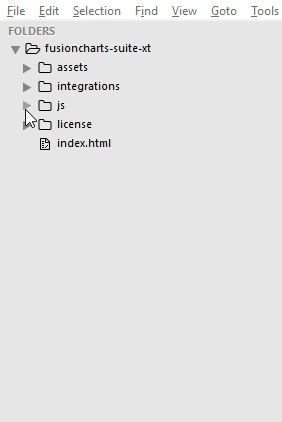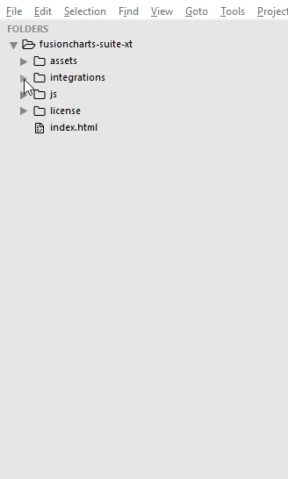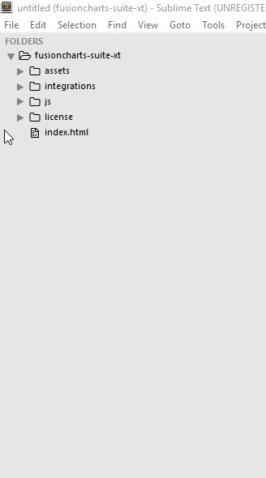Installation
FusionCharts Suite XT includes the FusionCharts server-side RoR wrapper that lets you create interactive, data-driven charts. Using the wrapper, you can create charts in your browsers without writing any JavaScript code. The required JavaScript and HTML code is generated as a string in the server and inserted in the web page to generate charts.
In this article, we will show you how to download and install the FusionCharts Rails gem wrapper and all the other dependencies on your system.
Download FusionCharts Library
In order to install and start working with Ruby on Rails and FusionCharts you need to download the FusionCharts Suite XT package which contains:
- JavaScript files to render Charts, Widgets, and PowerCharts in the
jsfolder. - JavaScript files to render maps in the
js > mapsfolder. - JavaScript files to apply themes in the
js > themesfolder.
The folder structure is shown below:

You need to copy all the files/folders from
fusioncharts-suite-xt > jsto thevendor/assets/javascripts/fusioncharts/folder of your Rails application.
- The download package contains FusionCharts gem under the
fusioncharts-suite-xt > integrations > rubyonrails > fusioncharts-wrapperfolder. This also contains the native RoR FusionCharts Export Handler . The folder structure is shown below:

The
rubyonrailsfolder in the FusionCharts Suite XT package is available from v3.13.0.
Following is the list of JavaScript files present in your fusioncharts-suite-xt > js folder:
| File Name | Description | |
|---|---|---|
fusioncharts.js |
This is the core FusionCharts library, which you need to import in all your pages where you want to generate a chart, gauge or a map. | |
fusioncharts.charts.js |
This file is required to render all charts present under FusionCharts XT. Note: When you include fusioncharts.js file in your page, you do not need to include this file separately, as fusioncharts.js internally loads fusioncharts.charts.js provided they are in the same folder. |
|
fusioncharts.widgets.js |
This file is required to render all gauges present under FusionWidgets XT. Note: When you include fusioncharts.js file in your page, you do not need to include this file separately, as fusioncharts.js internally loads fusioncharts.widgets.js provided they are in the same folder. |
|
fusioncharts.powercharts.js |
This file is required to render all charts present under PowerCharts XT. Note: When you include fusioncharts.js file in your page, you do not need to include this file separately, as fusioncharts.js internally loads fusioncharts.powercharts.js provided they are in the same folder. |
|
fusioncharts.gantt.js |
This file is required to render the Gantt chart. Note: When you include fusioncharts.js file in your page, you do not need to include this file separately, as fusioncharts.js internally loads fusioncharts.gantt.js provided they are in the same folder. |
|
fusioncharts.treemap.js |
This file is required to render the Treemap. Note: When you include fusioncharts.js file in your page, you do not need to include this file separately, as fusioncharts.js internally loads fusioncharts.treemap.js provided they are in the same folder. |
|
fusioncharts.zoomscatter.js |
This file is required to render the Zoom scatter chart. Note: When you include fusioncharts.js file in your page, you do not need to include this file separately, as fusioncharts.js internally loads fusioncharts.zoomscatter.js provided they are in the same folder. |
|
fusioncharts.zoomline.js |
This file is required to render the Zoom line charts. Note: When you include fusioncharts.js file in your page, you do not need to include this file separately, as fusioncharts.js internally loads fusioncharts.zoomline.js provided they are in the same folder. |
|
fusioncharts.overlappedbar2d.js |
This file is required to render the Overlapped Bar 2D chart. Note: When you include fusioncharts.js file in your page, you do not need to include this file separately, as fusioncharts.js internally loads fusioncharts.overlappedbar2d.js provided they are in the same folder. |
|
fusioncharts.overlappedcolumn2d.js |
This file is required to render the Overlapped Column 2D chart, present under FusionCharts XT. Note: When you include fusioncharts.js file in your page, you do not need to include this file separately, as fusioncharts.js internally loads fusioncharts.overlappedcolumn2d.js provided they are in the same folder. |
|
fusioncharts.maps.js |
This file is the core map renderer file. The map definitions, however, are stored separately, as explained next. Note: When you include fusioncharts.js file in your page, you do not need to include this file separately, as fusioncharts.js internally loads fusioncharts.maps.js provided they are in the same folder. |
|
maps/* |
This folder contains Map Definition files required by each map to be rendered by fusioncharts.maps.js. To keep the download package size small, it contains only 2 maps - fusioncharts.world.js and fusioncharts.usa.js. You can download the definition files of all the 1400+ maps offered by FusionMaps XT from here . Note: Replace the map definition files (of v3.12.2 or older) with the latest files available in download package while upgrading to v3.13.0. |
|
themes/* |
This folder contains pre-packaged themes that can be applied to charts, gauges, and maps to style them through a central FusionCharts theme files. Refer each theme with their respective JavaScript file names. |
To install FusionCharts Suite XT, simply copy and paste the JavaScript files from the downloaded package into your project folder.
After that, you can include the FusionCharts JavaScript library in your web applications and start building your charts, gauges, and maps. To include FusionCharts library files, follow the steps given below:
Step 1: Include the FusionCharts package
To include the core FusionCharts library in your project add the following line in the app/assets/javascripts/application.js file:
//= require fusioncharts/fusionchartsStep 2: Include the Theme file (optional)
//= require fusioncharts/themes/fusioncharts.theme.fusionTo add the FusionCharts Rails wrapper, use any of the following processes:
Gemfile:
gem ‘fusioncharts-rails’
$bundle
fusioncharts-rails gem. You can also install the gem directly from the command line prompt, without making any edits to the Gemfile. To do this, use the code line given below:
$gem install fusioncharts-rails
fusioncharts-suite-xt > integrations > rubyonrails > fusioncharts-wrapper folder.lib folder of your applicationInclude the FusionCharts Rails wrapper
To include the FusionCharts Rails wrapper in your controller:
require ‘fusioncharts-rails’This completes the installation of FusionCharts in your application. To see how to create a chart, click here .
Installing FusionMaps for your project
FusionCharts Suite XT provides 1400+ data-driven maps as a part of the FusionMaps product. To reduce the size of the download package, we have included the fusioncharts.maps.js file and only two map definition files - the World Map, and the Map of USA. However, you can download the remaining map definition files to plot maps of those countries/regions.
If you are using version v3.12.2 or older, download the latest version and replace for upgrading to the latest map definition files.
To render a map, you need to include the FusionCharts library in your project. Add the following code in the app/assets/javascripts/application.js file.
//= require fusioncharts/fusioncharts
//= require fusioncharts/fusioncharts.maps
//= require fusioncharts/maps/fusioncharts.worldTo add FusionMaps, use any of the following process:
Gemfile:
gem ‘fusioncharts-rails’
$bundle
fusioncharts-rails gem. You can also install the gem directly from the command line prompt, without making any edits to the Gemfile. To do this, use the code line given below:
$gem install fusioncharts-rails
fusioncharts-suite-xt > integrations > rubyonrails > fusioncharts-wrapper folder.lib folder of your applicationLoad other Map Definition files
To use any other map (except World and USA) from our 1400+ maps, download the map definition files and copy them to your current maps folder. The map definition files are named in fusioncharts.[MAP_ALIAS].js format, where MAP_ALIAS represents the country, state, or region name.
To include map definition files in your project add the following code in the app/assets/javascripts/application.js file. Assuming that you need to render the map of California, the alias name california replaces MAP_ALIAS in the format as shown below:
//= require fusioncharts/maps/fusioncharts.californiaClick here to explore all the maps available in FusionMaps XT.
Themes
Themes shipped with FusionCharts Suite XT allow you to apply centralized themes to any number of charts.
In a theme file, we can centralize the following aspects of all of your charts, gauges, and maps:
- Visual appearance (data plot color, font color, font size, etc.)
- Behavior (hover effects for data plots)
- Intelligence (applying different colors to the positive and negative data plots in all charts that use the theme)
The FusionCharts Suite download package also contains predefined theme files under fusioncharts-suite-xt > js > themes folder. The folder structure is shown below:

Include the theme files in the vendor/assets/javascripts/fusioncharts/ folder of your project.
Add the following code in the app/assets/javascripts/application.js file as shown below:
//= require fusioncharts/fusioncharts
//= require fusioncharts/themes/fusioncharts.theme.fusionOnly including the
fusioncharts.theme.fusion.jsfile will not apply the theme. To apply the theme, set the value ofthemeattribute to the respective theme name. For more details click here .